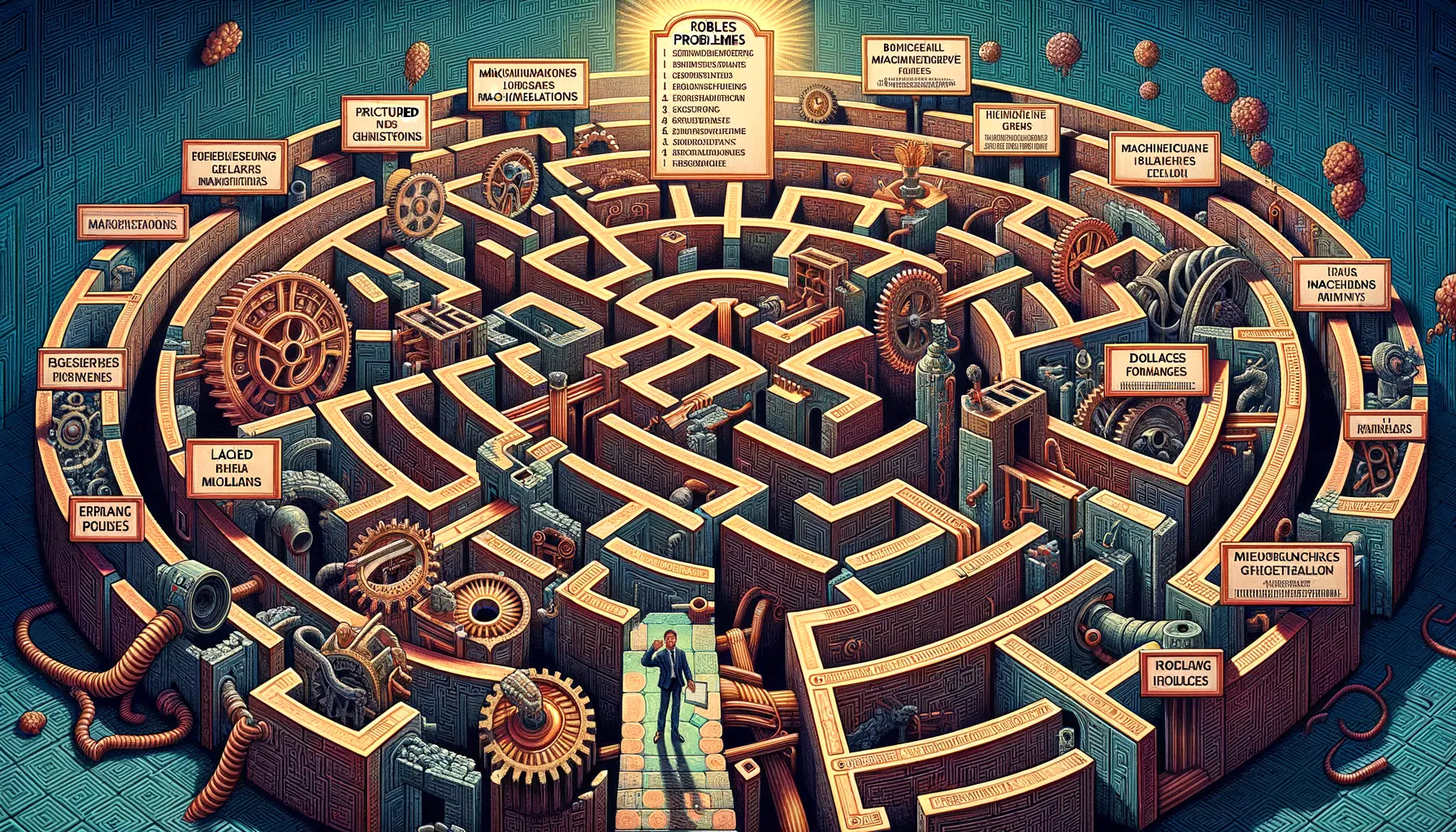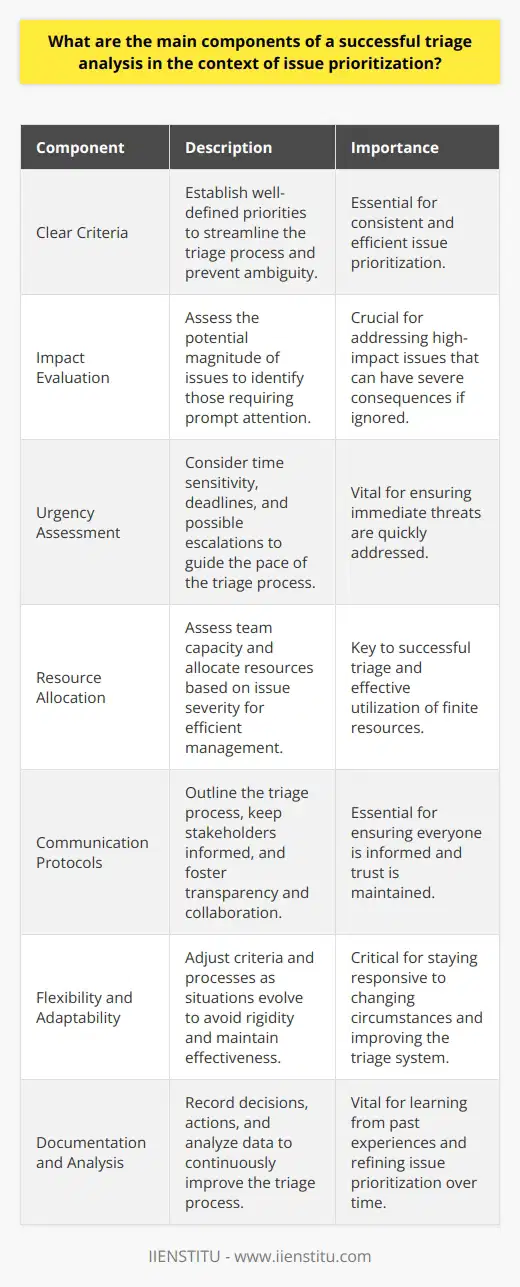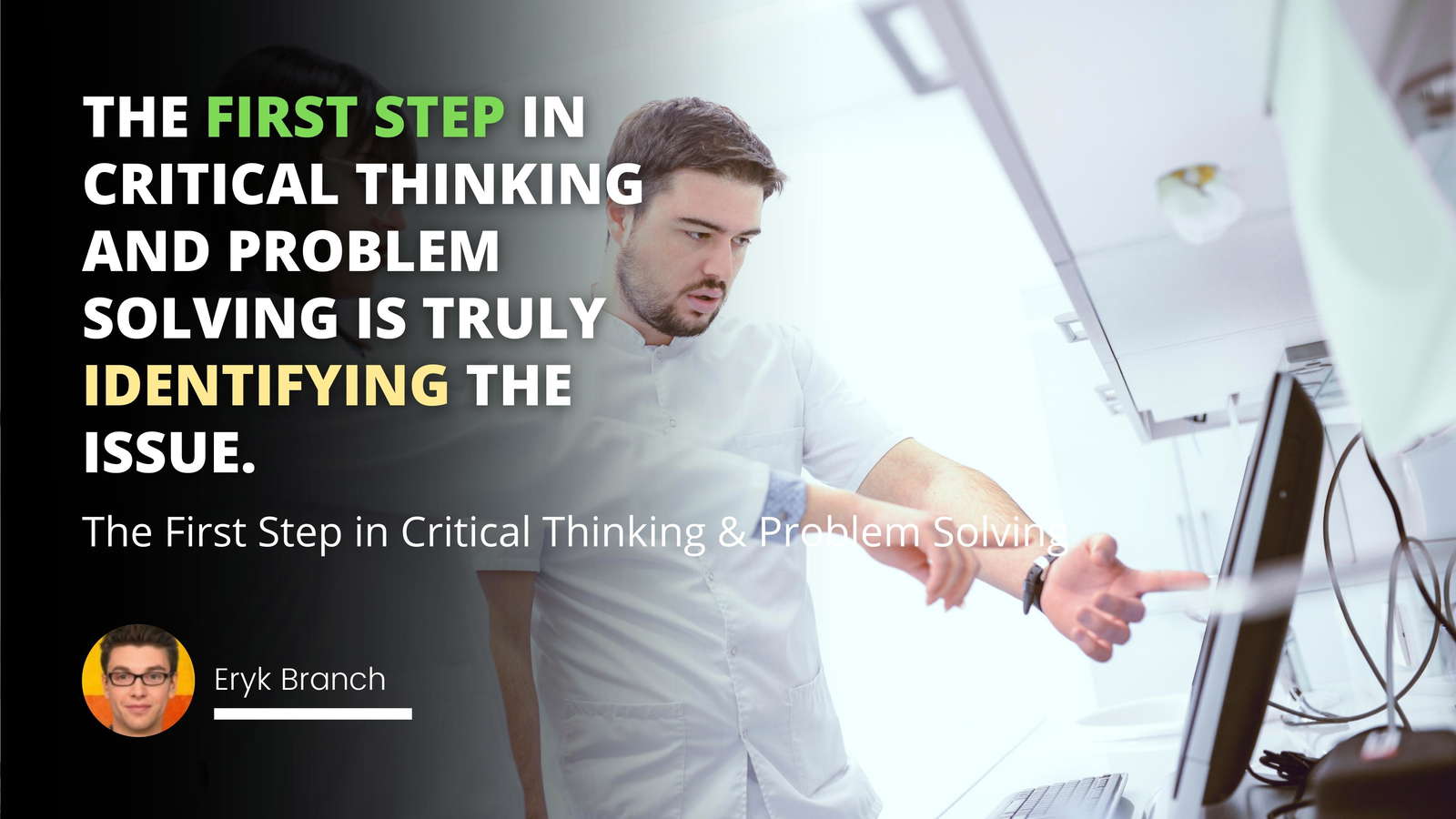
As society continues to evolve, the challenges within various sectors also become more complex and demanding. Circumstances necessitate an efficient approach to decision-making, especially when faced with high-pressure and high-stakes situations. This is where triage analysis becomes pivotal – a methodical process of sorting and prioritizing that is as vital in an emergency room as it is in the board room or within digital realms of data security. Embracing problem solving training courses and online certificate course offerings can equip professionals with the skills needed to excel in triage analysis. Let's delve into this strategic method, beginning with its fundamental principles, historical development, and its diverse applications across fields.
Introduction to Triage Analysis
Definition of Triage Analysis
Triage analysis is a systematic process of determining the priority of issues, problems, or patients, based on the severity of their conditions and the resources available to address them. It's a critical decision-making framework that enables professionals to respond effectively under pressure, ensuring that those who need the most immediate attention receive it promptly.
Importance of Triage Analysis in Various Sectors
In healthcare, triage analysis can mean the difference between life and death. Beyond the medical sphere, triage principles apply within business crisis management, cybersecurity incident response, and emergency management, to name a few, allowing for swift and effective action under duress. Ensuring that teams are proficient through ongoing problem solving training courses can dramatically enhance the outcomes in urgent scenarios across these sectors.
The Historical Development of Triage Analysis
Origin of Triage Analysis
The concept of triage has its roots in battlefield medicine, originating from the work of French surgeon Dominique Jean Larrey during the Napoleonic Wars. He developed a system that allowed for the rapid sorting of soldiers based on the severity of their injuries and the urgency of their need for medical attention.
Evolution and Improvement of Triage Techniques
Over the years, triage analysis has evolved significantly. The principles of efficiency, effectiveness, and fairness have been refined and adapted to suit a broad array of situations, growing from the battlefield to influence numerous other domains requiring urgent decision-making.
Current State of Triage Analysis
Today, triage analysis is a sophisticated field, incorporating advanced technology and predictive analytics to improve outcomes. Healthcare, business, and cybersecurity professionals all employ contemporary triage techniques to swiftly assess, prioritize, and respond to emergent issues.
Fundamental Principles of Triage Analysis
Assessment of Patient/Scenario Severity
The essence of triage analysis lies in its ability to rapidly assess the severity of a situation. In medical contexts, this involves determining the extent of a patient's injuries or illness. Similar assessment techniques are applied in other scenarios, like identifying critical failures in a production line or evaluating threats in a cybersecurity breach.
Prioritization of Action Steps
Upon assessing the severity of the various cases or issues at hand, triage analysis guides professionals in establishing a clear order of action. Those cases with the potential to rapidly deteriorate without intervention are typically addressed first.
Efficient Resource Allocation
A key component of triage analysis is the judicious allocation of resources to where they can have the most significant impact. For healthcare workers, this means distributing medical supplies and personnel where they are needed most. Similarly, in business and cybersecurity, it involves directing technical support and human capital to critical areas.
Different Triage Analysis Techniques
Basic Triage Analysis Techniques
Basic triage techniques, such as the START (Simple Triage and Rapid Treatment) method, focus on quick assessment and categorization of cases to determine urgency levels. This technique is especially prevalent in emergency situations, like natural disasters, where time and resources are limited.
Advanced Triage Analysis Techniques
Advanced techniques may incorporate more nuanced criteria and sophisticated tools, including software algorithms, artificial intelligence, and decision-support systems to augment the decision-making process.
Situation-specific Triage Analysis Techniques
Medical Triage Analysis
In the medical field, triage analysis is used by first responders and emergency room staff to evaluate patients based on the immediacy of their medical needs, ongoing vital signs, and potential for survival with immediate intervention.
Incident Response Triage Analysis in Cybersecurity
Cybersecurity professionals employ triage analysis to determine the severity of threats, the vulnerability of systems, and the order in which security incidents should be addressed to minimize damage and restore systems to normal operations.
Business Process Triage Analysis
Business leaders use triage analysis to manage crises by identifying critical business functions that must be sustained, allocating resources efficiently, and recovering operations. Failing to do so could lead to severe economic consequences and loss of stakeholder trust.
Application of Triage Analysis in Different Fields
Use in Healthcare Sector
In healthcare, triage is the linchpin that dictates patient flow and resource allocation during daily operations and unforeseen mass casualty events.
Application in Emergency Management
Triage plays a central role in emergency management, guiding the allocation of personnel and resources during natural disasters, terrorist attacks, or other large-scale emergencies.
Role in Business Processes Management
In the business arena, triage analysis assists in the prioritization of tasks, projects, and initiatives to align with strategic objectives and ensure business continuity during disruptions.
Importance in Cybersecurity
Cybersecurity relies on triage analysis to evaluate and prioritize responses to security incidents, ensuring that the threats posing the greatest risk are addressed first.
Case Studies to Highlight Use of Triage Analysis
Case Study 1: Triage Analysis in an Emergency Room Scenario
Analyzing cases from emergency room environments demonstrates the efficacy of triage in sorting patients based on the severity of their conditions, ultimately saving lives and optimizing the use of medical resources.
Case Study 2: Triage Analysis in a Business Crisis
Case studies of business crises illustrate how companies can use triage analysis to identify critical aspects of their operations that require immediate attention and to stabilize the organization.
Case Study 3: Triage Analysis in a Cyber Attack Incident
The examination of cyber attack incidents reveals how cybersecurity professionals employ triage principles to swiftly identify, isolate, and neutralize threats, thus minimizing damage to digital infrastructures.
Common Challenges and Solutions in Triage Analysis
Inaccurate Assessment and Prioritization
A common issue in triage analysis is the potential for misjudgment in the heat of the moment, which could lead to suboptimal prioritization and, consequently, wasted resources and poorer outcomes.
Inefficient Resource Allocation
Another challenge is the allocation of resources, which may not always correspond perfectly with the needs of a situation, sometimes causing delays in necessary interventions and reducing the effectiveness of the response.
Ways to Overcome these Challenges
To overcome these challenges, ongoing training, refining assessment tools, and incorporating technological advancements can greatly improve the accuracy and efficiency of triage analysis, no matter the context.
Future of Triage Analysis
Technological Innovations in Triage Analysis
As technological innovation progresses, so too does triage analysis. Artificial intelligence and big data analytics offer the potential to revolutionize how triage is conducted, promising more accurate assessments and predictions in real-time.
Emerging Trends in Triage Analysis Techniques
New trends in triage analysis are emerging, with more emphasis on standardized training, certifications, and online certificate course offerings to ensure that practitioners across various domains remain adept in the latest triage methodologies.
Preparation for Future Scenarios.
Preparation for future scenarios is crucial. Professional development through advanced problem solving training courses will be imperative for all sectors to stay ahead of the curve and ready to tackle the triage needs of tomorrow.
Recap of Triage Analysis Importance
Triage analysis is an indispensable strategy in the landscape of crisis management and daily operations across numerous fields. It has proven time and again to be the cornerstone of effective and efficient prioritization under duress.
Encouragement for Continuous Learning and Implementation
As the world continues to confront challenges of increasing complexity, the encouragement for professionals to engage in continuous learning through training and certification is paramount to mastering triage analysis.
Closing Thoughts
In closing, triage analysis remains a dynamic and essential skill that adapitates with our evolving needs. By continuing to study, train, and implement these principles, professionals can ensure the best possible outcomes even in the most challenging conditions.
Frequently Asked Questions
What are the main components of a successful triage analysis in the context of issue prioritization?
Triage Analysis in Issue Prioritization
Understanding Triage
Triage stems from medical practices. It ensures critical cases receive immediate attention. In business, triage applies to issue prioritization. It helps teams address the most pressing issues first.
Clear Criteria Establish Priorities
First, define what makes an issue urgent. Clear criteria prevent ambiguity. They streamline the triage process. Urgency, impact, and resource availability often dictate priority.
Impact Evaluation
Issues vary in magnitude. Assess their potential impact. High-impact issues demand prompt attention. Ignoring them can lead to severe consequences for a business.
Urgency Assessment
Time sensitivity is crucial. Immediate threats require quick action. Consider deadlines and possible escalations. Urgency guides the triage process's pace.
Resource Allocation
Resources are finite. Assess the team's capacity. Allocate resources based on issue severity. Efficient resource management is key to successful triage.
Communication Protocols
Communication ensures everyone is informed. It outlines the triage process. Regular updates keep stakeholders in the loop. Transparency fosters trust and collaboration.
Flexibility
Rigid triage systems falter. Adaptability is essential. Adjust criteria and processes as situations evolve.
Documentation and Analysis
Documentation is vital. Record decisions and actions. Use this data to analyze the triage process. Continuous improvement is the goal.
Consistent Review
Regularly review and refine the triage process. What works today may not tomorrow. Stay aware and proactive.
Conclusion
A successful triage analysis in issue prioritization hinges on clear, adaptable criteria. It balances impact, urgency, and resource allocation while fostering communication and documentation. Regular reviews ensure continuous refinement. Master these components to enhance issue prioritization.

How does triage analysis differ from other strategic approaches when prioritizing issues?
Triage Analysis: A Distinct Approach
Traditional strategic frameworks often opt for a systematic, comprehensive analysis. They delve into every issue with the same rigor. In contrast, triage analysis offers a streamlined method. It prioritizes issues based on immediate impact and resource availability.
Key Elements of Triage
- Urgency
- Impact
- Resources
Urgency dictates the queue. Impact assesses the potential effects. Resources consider availability and allocation. Combined, they offer a framework that is both dynamic and responsive.
Differentiation through Efficiency
In triage, not all issues gain equal attention. They are sorted into categories. These usually include high, medium, and low priority. High-priority issues demand immediate action. Medium may require attention but not immediately. Low priority can often wait or even be ignored.
The Benefits of Triage Analysis
Speed stands as the primary advantage. Triage allows for swift decision-making. It addresses the most critical situations first. Secondary matters receive attention only as time permits. This approach ensures that resources focus on where they are most needed.
Strategic Frameworks Compared
Consider SWOT analysis. It identifies strengths, weaknesses, opportunities, and threats. Each factor gets attention. Resources may spread thinly across many issues. This differs markedly from triage’s focused approach.
Another method, the Balanced Scorecard, offers a multifaceted view. It balances financial, customer, internal process, and learning perspectives. Triage, in contrast, prioritizes based on immediate need alone.
Triage in Practice
Embracing triage means accepting a dynamic environment. Priorities can shift with circumstances. What is urgent today may change tomorrow. Leaders using triage must stay adaptable. They must respond to the changing landscape of needs.
Conclusion
In essence, triage analysis stands out as a strategic approach. It offers a clear, pragmatic way to tackle pressing issues. It differs fundamentally from other strategic methods. These often seek balance and comprehensive review. Triage, however, spotlights immediate needs. It therefore serves as a critical tool in fast-paced or resource-constrained environments.

Can you provide an example of how a triage analysis might be used in a real-world, non-medical scenario to systematically prioritize issues?
Understanding Triage in Non-Medical Contexts
Triage, a term deep-rooted in medical fields, extends beyond. It denotes sorting and prioritizing. Non-medical scenarios often benefit from triage. Its essence lies in efficient resource allocation.
Triage Fundamentals
At its core, triage is systematic. It offers a structured approach to chaos. Certain principles guide this process. They are universality, scalability, and adaptability. Triage frameworks can tailor to diverse settings.
Real-World Triage: An Illustration
Consider an IT department swamped by requests. Diverse issues pop up constantly. To manage effectively, triage becomes crucial.
Step 1: Issue Collection
Initially, one must gather all issues. Collect them into a single repository. This simplifies subsequent analysis.
Step 2: Categorization
Next, categorize the issues. Common categories include:
- Critical: Affects many users; stops work.
- High: Impairs functionalities; affects some.
- Medium: Annoying; non-essential systems suffer.
- Low: Minor bugs; user experience dips slightly.
Step 3: Prioritization
Once categorized, prioritize. First tackle critical problems. They impede major functions.
Step 4: Resources Allocation
Distribute resources wisely. Allocate more to pressing issues. Less urgent problems receive fewer resources.
Step 5: Continuous Reassessment
Regularly reassess the situation. Shift priorities as needed. New issues might arise. Others may escalate.
Benefits in Non-Medical Sectors
Triage transcends industries. It organizes work in software development. It guides disaster response efforts. Customer service departments use it adeptly. It is a universal tool.
Efficient Problem-Solving
Triage streamlines processes. It helps identify quick wins. These are issues solvable with minimal effort. Clearing these fast frees up resources.
Optimal Resource Utilization
By focusing on severity, resources get used efficiently. Critical issues don't languish. Other tasks do not distract from them.
Improved Customer Satisfaction
Clients see swift action on major issues. This builds trust. It demonstrates commitment to service excellence.
In Conclusion
Triage analysis is a versatile tool. It extends well beyond medical situations. It helps various sectors systematically prioritize issues. Adopting triage can spell the difference. It can turn chaos into order. It directs focus to where it's most needed. Thus, it proves indispensable.



